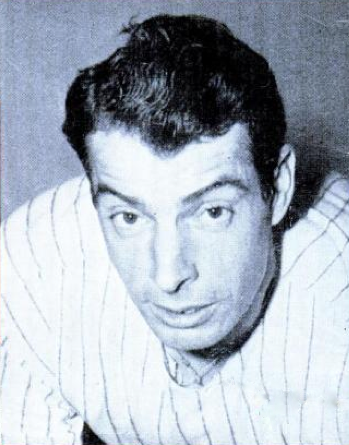Editor’s note: The following story is an excerpt from WEHOville publisher Henry Scott’s book “Shocking True Story: The Rise and Fall of Confidential, America’s Scandalous Scandal Magazine.”

[dropcap]O[/dropcap]n a moonless night on Nov. 5, 1954, Frank Sinatra found himself standing under the Chinese elms on a quiet West Hollywood street trying to reason with Joltin’ Joe DiMaggio, the Yankee Clipper himself, whose judgment had been clouded by too many stiff ones at a club on nearby Sunset Boulevard. Standing with them was Barney Ruditsky, a private investigator whose bespectacled and friendly face seemed ill-matched to his terrier disposition, and Phil Irwin, Ruditsky’s cocky young sidekick. It was an impressive gathering for Kilkea Drive, a street that would never appear on anyone’s map of Hollywood stars. Their focus was the house at Number 754.
It was and is an unremarkable house, built in the postwar construction frenzy for a single family. Its two stories of stucco with red tile trim are an homage to California’s Spanish heritage contradicted by a fake mansard roof and a vaguely Dutch entry. By the early 1950s it had been carved into three apartments to better suit the changing character of the neighborhood, where single young men and women whose careers were waxing mixed with oldsters whose lives were on the wane. One of those young women was Sheila Stewart, a little-known bit player, who lived upstairs.
This quiet block was familiar to Ruditsky and Irwin, who had kept a close watch on Stewart’s apartment for weeks. But it wasn’t Sheila they were interested in. On DiMaggio’s behalf, the two private investigators had been tracking “the Shape,” the swivel-hipped glamour girl whose marriage to the ballplayer 10 months earlier had been Hollywood’s most celebrated wedding since Mary Pickford swapped rings with Douglas Fairbanks Jr. Marilyn Monroe had become a frequent guest at 754 Kilkea Drive, and, as Ruditsky put it, “these weren’t just girlish bunking parties.”

In a sense, DiMaggio had no claims on Monroe. Only months after their marriage, it became clear that he wasn’t going to realize his ambition to turn America’s favorite sex kitten into a retiring homemaker and mother. Instead of settling into DiMaggio’s home in San Francisco, Monroe had headed to New York after the marriage to film “The Seven Year Itch.” In late September, they separated. And on October 28, Monroe stood before a judge in Santa Monica to testify that the famed baseball player had treated her with “coldness and indifference” when she had expected “love, warmth, and affection.” She walked out of the courthouse with an uncontested divorce.
But DiMaggio couldn’t let her go. He still loved Marilyn, and the possibility of another man nagged at him as he drank on the Strip that Friday night in November. The other man he had in mind was Hal Schaefer, a vocal coach who had coached Marilyn in hits such as “There’s No Business Like Show Business” and who, according to Ruditsky, was a regular visitor at Sheila Stewart’s apartment. When Irwin bumped into DiMaggio at the Sunset club, the ballplayer was brimming with liquid courage, and he demanded that Irwin come with him for a showdown.
A panicked Irwin called Ruditsky, who called Sinatra, who dragged along his manager, Henry Sanicola, and Patsy D’Amore, the owner of the Villa Capri, the restaurant where he and Sanicola had been dining. By the time their cars crept onto Kilkea, DiMaggio had formulated a plan, and none of his friends could dissuade him. One of them would stand on the sidewalk to see who ran out the front door while the rest of the men crashed through the back.
Ruditsky was afraid of what DiMaggio would do if he caught Schaefer with Monroe. So he convinced DiMaggio to stand outside and let him lead the attack. Ruditsky put his shoulder down and charged the rear door, four or five times in all. Finally it crashed to the floor, and Barney and his buddies tumbled over one another into the apartment. Shrill screams led the posse to a bedroom, where Ruditsky flung open the door while Irwin hoisted his camera and set off a blinding flash. Then Ruditsky flicked on the bedroom light to reveal the terrified countenance of one Florence Ross Kotz, clutching her bedclothes around her and howling like a banshee. It took only seconds for the men to realize they’d busted into the wrong apartment. And it took only minutes for them to hit the street, leaving behind the frightened Miss Kotz and a badly damaged door. As they piled into their cars and sped away, they could hear the siren of an approaching police car.
The incident at 754 Kilkea was rated an ordinary breaking and entering. Miss Kotz didn’t know what had hit her. If LA’s notoriously corruptible cops knew the identity of her late-night guests, they weren’t talking. The sordid details went into a locked file cabinet in Barney Ruditsky’s office to which only Barney and his trusted associate, Phil Irwin, had the key. Ruditsky could relax knowing the file cabinet, a tainted police department, and a lazy and compromised Hollywood press corps would protect the reputations of America’s most famous crooner and most beloved athlete, not to mention his own private investigator’s license.
But while Ruditsky was breathing a sigh of relief, the perpetually broke Irwin spent the next few months thinking about the cheaply printed magazine with the lurid red and yellow covers that was turning the town on its ear. Every private eye in Los Angeles knew that Confidential magazine, would pay well for information about scandals that no one else could or would touch. Irwin, known for letting his affair with the bottle and an occasional skirt get in the way of his good sense, used his key to slip the Monroe/DiMaggio file out of Ruditsky’s file cabinet.
In early August 1955, 10 months later, hundreds of trucks fanned out across America carrying more than four million copies of Confidential with a cover that promised to give its readers “The Real Reason for Marilyn Monroe’s Divorce: From a Detective’s Report.” Bobbysoxers who swooned when Ol’ Blue Eyes opened his mouth saw a candidate for the Three Stooges. Barnie Ruditsky lost his private investigator license. Phil Irwin was beaten and dumped in a telephone booth by Sinatra’s friends. Confidential’s newsstand sales soared above those of TV Guide and Life, cementing its reputation as the best-selling magazine on America’s newsstands.
MORE ON MONROE/SINATRA IN WEHO:
Marilyn Monroe and Frank Sinatra: Five Iconic Moments in West Hollywood
Monroe/Sinatra Nest Going For $4.75 Million
